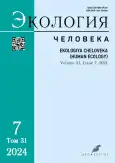Тенденции изменений физического развития дошкольников Республики Саха (Якутия)
- Авторы: Попов В.И.1, Скоблина Н.А.2, Жуков О.Ф.3, Семёнов Ю.И.4
-
Учреждения:
- Воронежский государственный медицинский университет им. Н.Н. Бурденко
- Российский национальный исследовательский медицинский университет им. Н.И. Пирогова
- Институт коррекционной педагогики Российской академии образования
- Автономная некоммерческая организация гармоничного развития детей «Лаборатория детства» Республики Саха (Якутия)
- Выпуск: Том 31, № 7 (2024)
- Страницы: 553-559
- Раздел: ОРИГИНАЛЬНЫЕ ИССЛЕДОВАНИЯ
- URL: https://journal-vniispk.ru/1728-0869/article/view/314529
- DOI: https://doi.org/10.17816/humeco643187
- ID: 314529
Цитировать
Полный текст
Аннотация
Цель исследования. Изучение тенденций физического развития дошкольников, проживающих в Республике Саха (Якутия).
Материалы и методы. В 2024 г. проведено изучение физического развития дошкольников Республики Саха (Якутия). В основную группу вошли 126 мальчиков и 120 девочек. Для сравнения использовали данные о физическом развитии дошкольников Республики Саха (Якутия), полученные в 2002 г. В группу сравнения вошли 90 мальчиков и 79 девочек Исследование соответствовало требованиям биомедицинской этики. Для обработки данных использовали пакет статистических программ Statistica 13 PL.
Результаты. В 2024 г. у мальчиков и девочек показатели длины тела плавно нарастают от пяти к шести годам, мальчики превосходят девочек, что соответствует закономерностям роста и развития. Во всех возрастно-половых группах дошкольников в 2024 г. наблюдается тенденция к увеличению средних значений показателей длины тела, массы и функциональных показателей — мышечной силы и жизненной ёмкости лёгких по сравнению с 2002 г.
Заключение. У дошкольников Республики Саха (Якутия) наблюдается тенденция к увеличению длины тела, массы тела и ускорению сроков биологического созревания, а также изменяются функциональные показатели, что может свидетельствовать о проявлениях процесса акселерации в регионе.
Ключевые слова
Полный текст
Открыть статью на сайте журналаОб авторах
Валерий Иванович Попов
Воронежский государственный медицинский университет им. Н.Н. Бурденко
Email: 9038504004@mail.ru
ORCID iD: 0000-0001-5386-9082
SPIN-код: 8896-9019
д-р мед. наук, профессор
Россия, ВоронежНаталья Александровна Скоблина
Российский национальный исследовательский медицинский университет им. Н.И. Пирогова
Email: skoblina_dom@mail.ru
ORCID iD: 0000-0001-7348-9984
SPIN-код: 4269-6361
Scopus Author ID: 8285540900
ResearcherId: Y-8078-2018
д-р мед. наук, профессор
Россия, МоскваОлег Фёдорович Жуков
Институт коррекционной педагогики Российской академии образования
Email: ofzhukov@mail.ru
ORCID iD: 0000-0001-5879-2387
SPIN-код: 8847-5922
канд. пед. наук, доцент
Россия, МоскваЮрий Иванович Семёнов
Автономная некоммерческая организация гармоничного развития детей «Лаборатория детства» Республики Саха (Якутия)
Автор, ответственный за переписку.
Email: yra_semen1109@mail.ru
ORCID iD: 0000-0002-8766-3936
SPIN-код: 2911-1365
Россия, Якутск
Список литературы
- Petrova EV. Homo informaticus: biological and socioanthropotechnical evolution. Humanitarian Vector. 2022;17(2):25–34. doi: 10.21209/1996-7853-2022-17-2-25-34 EDN: LVBNND
- Lebedeva LS, Kucherova YuA, Godina EZ. Cartographic method for studying secular trend in male stature in Russia and neighboring countries in the 19–20th centuries. Lomonosov Journal of Anthropology (Moscow University Anthropology Bulletin). 2022;(1):41–53. doi: 10.32521/2074-8132.2022.1.041-053 EDN: RIWYZY
- Popov VI, Ushakov IB, Levushkin SP, et al. Long-term dynamics of the physical development of children in Russia. Ekologiya cheloveka (Human Ecology). 2022;29(2):119–128. doi: 10.17816/humeco96734 EDN: LEWQYC
- Safonenkova EV. Secular trend and development prospects (literature review). Journal of New Medical Technologies, Eedition. 2022;16(3):83–90. doi: 10.24412/2075-4094-2022-3-3-4 EDN: URHUXG
- Saldan IP, Filippova SP, Zhukova OV, et al. Current trends in changes of physical development indicators of children and adolescents. Bulleten Medicinskoj Nauki. 2019;(1):14–20. doi: 10.31684/2541-8475.2019.1(13).14-20 EDN: KCYDDW
- Egorova GA, Kuchma VR, Skoblina NA, Timofeev VN. Factors affecting the physical development of children living in Vilyuysky Ulus of the Republic of Sakha (Yakutia). RUDN Journal of Medicine. 2005;(2):85–91. (In Russ.) EDN: NYAIID
- Everstova AV, Petrova PG, Egorova GA. Physical development of Yakut preschool-age children living in rural area of the RS (Y). Yakut Medical Journal. 2006;(2):20–23. EDN: KGLEGR
- Burtseva TE. Physical development of RS (Y) children: age and ethnic features. Yakut Medical Journal. 2010;(2):5–6. EDN: OYPEWZ
- Baranov AA, Kuchma VR, Sukhareva LM, et al. Universal assessment of the physical development of younger schoolchildren. Moscow: NCSD of the Russian Academy of Medical Sciences; 2010. 34 р. (In Russ.) EDN: XUSPVB
- Marinova LG, Markova SV, Zakharova NM, et al. Physical development of preschool children of municipal districts of the republic of Sakha (Yakutia). Yakut Medical Journal. 2023;3(3):58–61. doi: 10.25789/YMJ.2023.83.14 EDN: FXTONA
- Marinova LG, Markova SV, Egorova VB, et al. Physical development of preschool children in the city of Yakutsk, republic of Sakha (Yakutia). Treatment and Prevention. 2024;14(1):21–27. EDN: PJFNYM
- Kuchma VR, Skoblina NA, Milushkina OYu, Bokareva NA. Comparative analysis of physical and biological development of schoolchildren in Moscow. Hygiene and Sanitation, Russian Journal. 2012;91(4):47–52. EDN: PTUMXP
- Pavlovskaja VS, Kalishev MG, Rogova SI. Long-term dynamics of changes of anthropometrical indices of school students. Hygiene and Sanitation, Russian Journal. 2020;99(3):286–290. doi: 10.33029/0016-9900-2020-99-3-286-290 EDN: BRGTFT
- Yatsenko AK, Pervov YuYu, Trankovskaya LV. Regional features dentition in preschool and primary school age in Vladivostok. Russian Journal of Dentistry. 2017;21(1):45–49. doi: 10.18821/1728-28022017;21(1)45-49 EDN: YHTGNP
- Yatsenko AK, Pervov YuYu, Trankovskaya LV, Kutuzova NV. Influence of biological factors on secondary dentition in children aged 3–11 years in Vladivostok. Medical Newsletter of Vyatka. 2019;(2):22–26. EDN: CQACOP
- Popov VI. Hygienic characteristics of approaches, characterizing the age features and health indicators of children, adolescents and youth. Health Care of the Russian Federation. 2019;63(4):199–204. doi: 10.18821/0044-197X-2019-63-4-199-204 EDN: CBQIZO
- Marfusalova VP, Sakerdonova AS. A study of the readiness of children of small indigenous peoples of the North to study at school (based on the material of the Republic of Sakha (Yakutia). European Social Science Journal. 2018;(10):331–336. EDN: DHVKOH
- Levushkin SP, Sonkin VD, Platonova RI. Schoolchildren's physical development rating cross-regional analysis in different regions of the Russian Federation. Fizicheskaya Kultura: Vospitanie, Obrazovanie, Trenirovka. 2018;(6):22–24. EDN: YMRBLN
- Berezina NO, Nikitina MA, Khramtsov PI. Characteristics of functional capacities in present-day preschool children. Russian Pediatric Journal. 2011;(3):39–42. EDN: NXBJUN
- Gerasimova AA, Krivolapchuk LI, Chernova MB. Alue of digital load and features of the functional state ofpreschoolers with high and low physical activity. Uchenye Zapiski Universiteta Imeni P.F. Lesgafta. 2021; (10):86–93. doi: 10.34835/issn.2308-1961.2021.10.p86-93 EDN: IYABSJ
Дополнительные файлы







